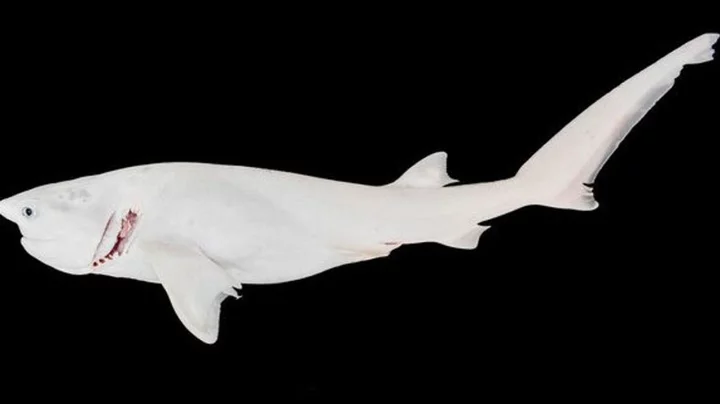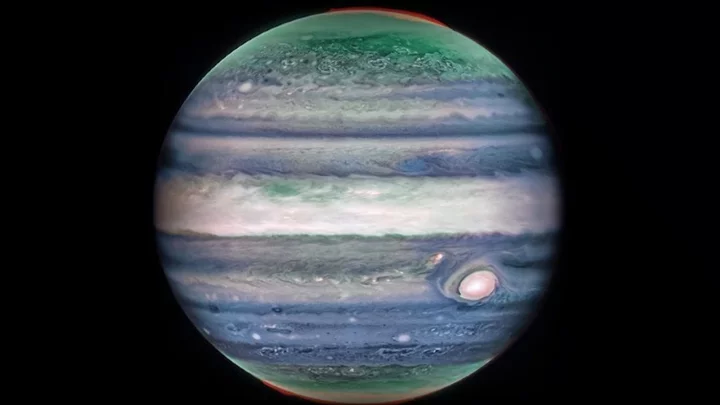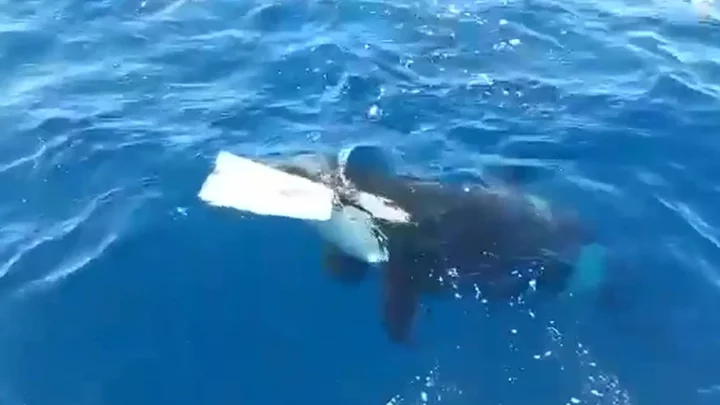
Bozophobia: A New Study Explains Why We Fear Clowns
There's new insight into the reasons we're not down with clowns.
2023-11-01 02:50

Scientist claims that humans have ‘no free will’ after decades of research
Human beings are fascinating creatures and one of the oldest philosophical debates is over whether people truly have free will or not. For millennia, scientists have debated over whether free will is simply an illusion of the mind and is a concept that doesn’t even exist, or, if our species naturally possess it. Some experts, such as the philosopher Bernardo Kastrup, argue that we do have free will. He defined it as existing “if our choices are determined by that which we experientially identify with”. Kastrup claimed that his “tastes and preferences” are “consciously felt by” him, thus the choices he makes are “determined by these felt tastes and preferences”. Essentially, Kastrup argues, we are able to choose what action to perform and this gives humans a level of free will. On the other hand, neurobiologist Robert Sapolsky from Stanford University believes humans don’t have any free will, after studying the subject for “decades”. In his book Determined: A Science of Life Without Free Will, Sapolsky argues that almost all of our behaviour as humans is beyond our own conscious control. He argued: “The world is really screwed up and made much, much more unfair by the fact that we reward people and punish people for things they have no control over. “We’ve got no free will. Stop attributing stuff to us that isn’t there.” Sapolsky believes that behaviour that we believe originates from free will is actually related to your environment, body, upbringing and genes. Speaking on the CultureLab podcast by New Scientist, Sapolsky explained: “In terms of my orientation, my basic approach is you look at a behaviour and someone has just done something that’s wonderful or awful or ambiguously in-between or in the eyes of the beholder, but some behaviour has happened, and you ask, 'Why did that occur?' and you’re asking a whole hierarchy of questions.” He continued explaining that the prompts to our behaviour could include, “which neurons did what, 10 milliseconds before” and may even originate from “this morning’s hormone levels” and the impact this has on your sensitivity levels in the brain. Additionally, behaviour, he argues can determined by prior trauma and even go back to the “childhood and foetal environment” and our individual genes. To summarise, he argued: “If you’re talking about genes, by definition, genes and behaviour, by definition, you’re talking about evolution and you’re talking about neurobiology and genetic variance and neuronal function. “If you’re talking about, you know, early trauma in life, you’re talking about epigenetics and you’re talking about adult propensity. “So, they’re all one continuous seam of influences, and when you look at it that way, there’s not a damn crack anywhere in there to shoehorn in a notion of free will.” Sign up to our free Indy100 weekly newsletter How to join the indy100's free WhatsApp channel Have your say in our news democracy. Click the upvote icon at the top of the page to help raise this article through the indy100 rankings.
2023-10-31 23:29

Dinosaur-killing asteroid impact fouled Earth's atmosphere with dust
By Will Dunham WASHINGTON It was, to put it mildly, a bad day on Earth when an asteroid
2023-10-31 01:19

Mysterious holes discovered on the outside of the International Space Station
If there’s one thing astronauts don’t want to face when out in the endless expanse of space, it’s signs that their station is being sabotaged. And yet, cosmonauts Oleg Kononenko and Nikolai Chubwere forced to face a strange phenomenon during a spacewalk last week. The pair exited the International Space Station (ISS) on Wednesday to fix a radiator which had sprung a leak. And while they were out, they were met by a close encounter of a very strange kind. Inspecting the source of the leak during their outing, Kononenko reported seeing a number of holes on the radiator panel. "The holes have very even edges, like they've been drilled through," he told Moscow Mission Control, according to Space.com. "There are lots of them. They are spread in a chaotic manner." The cosmonauts were given tissues and cloths to soak up any fluid that had seeped out of the radiator, with the pool of liquid coolant described as a growing “blob”. However, Kononenko got so close to the “blob” that one of his tethers became contaminated. This meant that it had to be bagged up and discarded outside the ISS before the cosmonauts could go back inside. The external radiator was mounted on the outside of Russia’s Nauka module – home to a multipurpose laboratory – which was launched in 2021. It was used as a backup to another radiator which regulates the temperature inside the lab. Kononenko and Chub closed a number of valves to cut off the external radiator from its ammonia supply, and it’s believed that the “blob” formed from residual ammonia that was disturbed when the valves were being shut. The toxic liquid certainly wouldn’t have been welcome on board the space station, hence why the two colleagues embarked upon their spacewalk armed with cloths to wipe down their spacesuits and tools. Russian engineers on the ground will use the data they collected to further investigate the cause of the leak and figure out how to fix the radiator. The question now is will they be able to work out where those mysterious little holes came from? Sign up for our free Indy100 weekly newsletter Have your say in our news democracy. Click the upvote icon at the top of the page to help raise this article through the indy100 rankings
2023-10-29 23:57

Scientist discovers oldest water on Earth and drinks it
A scientist who found the oldest water ever discovered on Earth decided the best course of action was, of course, to drink it. Professor Barbara Sherwood Lollar was leading a team of geologists studying a Canadian mine in 2016 when she made the remarkable discovery. The flowing water about three kilometres below the surface was between 1.5bn and 2.6bn years old, according to tests, making it the oldest water found on Earth. “When people think about this water they assume it must be some tiny amount of water trapped within the rock,” said Prof Sherwood Lollar. “But in fact it’s very much bubbling right up out at you. These things are flowing at rates of litres per minute – the volume of the water is much larger than anyone anticipated.” Upon tasting the ancient water, she found that it was “very salty and bitter” and “much saltier than seawater”. That was an encouraging sign, because saltier water tends to be older. In this case, where the water has been ageing for billions of years, it is hardly surprising. “If you’re a geologist who works with rocks, you’ve probably licked a lot of rocks,” said Sherwood Lollar. Her team also found that life had once been present in the water, by looking at the sulphate – the composition of salts – in it. “We were able to indicate that the signal we are seeing in the fluids has to have been produced by microbiology – and most importantly has to have been produced over a very long time scale. “The microbes that produced this signature couldn’t have done it overnight. “This has to be an indication that organisms have been present in these fluids on a geological timescale.” Fortunately, the scientist had no terrifying sci-fi movie-esq reaction to drinking the ancient water, and lived to tell the tale. The paper was published in Nature in 2016. How to join the indy100's free WhatsApp channel Sign up to our free Indy100 weekly newsletter Have your say in our news democracy. Click the upvote icon at the top of the page to help raise this article through the indy100 rankings.
2023-10-27 00:29

Scientists have discovered a ghost-white shark with a rare condition
Scientists have discovered a ghost-white shark with a rare condition. The predator was accidentally hooked by fishermen dedicated to catching sole. They were working from the coastal area of Los Chimus in Peru and informed authorities of the find. At the time of its capture, the shark had injuries to its gill slits as a result of being caught up in the net last month. The marine animal was transferred to the Peruvian Institute of the Sea (IMARPE) in Chimbote to undergo tests. Scientists discovered that the shark had leucism, which causes partial loss of pigmentation. The condition differs to albinism, which is a complete lack of melanin - a substance in the body that produces hair, eye and skin pigmentation. Albinos often have pink or red eyes but while leucism often makes an animal’s skin white, it does not affect their eye colour. IMARPE said this is the first known case of a shark in Peruvian waters having this condition. The fish was a young female that measured 89cm in length. Sexual maturity in females takes place when they are around 220cm in length. The predatory species sits high on the trophic food chain and mostly feeds on other sharks, rays, cetaceans and sea lions. Broadnose sevengill sharks are known to hunt in packs to bring down large prey. They are recognisable by their seven gill slits as most shark species have five. Sign up for our free Indy100 weekly newsletter How to join the indy100's free WhatsApp channel Have your say in our news democracy. Click the upvote icon at the top of the page to help raise this article through the indy100 rankings
2023-10-26 21:21

Meta is being sued by 41 states over ‘addictive’ content allegedly harmful to children
Mark Zuckerberg's Meta is facing lawsuits from 41 states alleging there are addictive features aimed at hooking young users. The filings allege that Meta knowingly uses features on their platforms Instagram and Facebook to pull in and addict children. States are also claiming that Meta's algorithms were designed to coerce children into harmful content with features like "infinite scroll" and persistent notifications hoooking young users to continue using the app. Meta has been accused of violating federal privacy laws for children and consumer protection laws. The 233-page joint complaint obtained by Deadline, states: "Research has shown that young people's use of Meta's Social Media Platforms is associated with depression, anxiety, insomnia, interference with education and daily life, and many other negative outcomes. "Nonetheless, Meta has continued to deny and downplay these harmful effects to the pubic and to promote its Platforms as safe for young users." The complaint also said that the company's "motive is profit, and in seeking to maximise its financial gains, Meta has repeatedly misled the pubic about the substantial dangers of its Social Media Platforms." Weighing in on the lawsuit, a Meta spokesperson said: "We share the attorney general's commitment to providing teens with safe, positive experiences online, and have already introduced over 30 tools to support teens and their families. We're disappointed that instead of working productively with companies across the industry to create clear, age-appropriate standards for the many apps teens use, the attorneys general have chosen this path." In May, U.S. Surgeon General Vivek Murthy called social media a "profound risk" for youth and encouraged parents to restrict their children's access to it. Sign up to our free Indy100 weekly newsletter How to join the indy100's free WhatsApp channel Have your say in our news democracy. Click the upvote icon at the top of the page to help raise this article through the indy100 rankings.
2023-10-25 17:25

This Chinese martial art may slow down Parkinson’s disease
Practicing one particular Chinese martial art could help curb symptoms and complications of Parkinson’s disease for several years, according to a new study. Regular practice of Tai Chi, which involves sequences of very slow controlled movements, is linked with slower progression of the debilitating neuro-degenerative condition, with patients likely to require lower doses of drugs over time, according to the research published in the Journal of Neurology Neurosurgery & Psychiatry. Parkinson’s disease is a progressive disorder affecting nerves and muscles, characterised by slowness of movement, resting tremor and stiff and inflexible muscles. It is the fastest growing neurological condition in the world, with two people in the UK diagnosed with the disease every hour, according to Parkinson’s UK. There are still no cures for the condition and while drugs can improve symptoms, they don’t treat all manifestations of the disease. Previous research had hinted that Tai Chi may have some positive effects on Parkinson’s patients, but whether this can be sustained over a long term isn’t known. In the new study, scientists, including those from Shanghai Jiao Tong University in China, monitored two groups of patients with Parkinson’s disease for more than five years from January 2016 to June 2021. Disease severity, medication use, age and education level were found to be similar in both the groups. One group of 147 patients practised Tai Chi twice a week for an hour, while another group of 187 patients continued with their standard care, but didn’t practise the martial art. Doctors monitored disease severity and progression in all the participants as well as their increases in the need for medication at the start of the monitoring period and in November 2019, October 2020 and June 2021. The extent of movement, mood, sleep quality and cognition as well other symptoms like the prevalence of complications like involuntary movement (dyskinesia), abnormal muscle tone (dystonia), hallucinations and restless leg syndrome were also tracked. Scientists found that disease progression was slower at all monitoring points in the Tai Chi group, as assessed by three validated scales to assess overall symptoms, movement and balance. They also found that the number of patients who needed to increase their medication in the comparison group was “significantly higher” than it was in the Tai Chi group. Researchers said cognitive function deteriorated more slowly in the Tai Chi group, while sleep and quality of life also continuously improved. However, scientists acknowledge that the study is observational and can’t establish cause and effect. Citing another limitation of the research, they said the number of study participants was relatively small. “Our study has shown that Tai Chi retains the long-term beneficial effect on [Parkinson’s disease], indicating the potential disease-modifying effects on both motor and non-motor symptoms, especially gait, balance, autonomic symptoms and cognition,” scientists concluded. Read More The 10 products to make 2023 your healthiest year yet Tai chi improves balance, mental health in elderly: study Non-invasive deep brain stimulation ‘could provide treatment for brain diseases’ Daily exercise for just 25 minutes may cut death risk from prolonged sitting Mysterious ancient ‘human face’ rock carvings revealed by receding waters in Amazon Bumblebees ‘prioritise getting maximum calories in shortest time’
2023-10-25 15:23

Convincing yourself food is highly calorific could suppress your appetite
A study suggests that convincing yourself that food has a higher calorie content may suppress your appetite and help you lose weight. Alia Crum and her colleagues at Yale University gave 46 healthy volunteers the same 380-calories milkshake. However, some participants were told it was a low-calorie choice, whilst others were told it was high in calories. The 'low-calorie' bottle of the shake claimed it to have zero percent fat, zero added sugar and be only 140 calories. Whilst the 'high-calorie' bottle was labelled as 'indulgent' and accounted to 620 calories. The team measured levels or ghrelin before and after volunteers drank the shake. Ghrelin is a hormone released by the stomach when we are hungry. "It also slows metabolism," Crum said, "just incase you might not find that food." Once you have a big meal after you ghrelin rises, your level proceed to drop again, telling your brain that you've had enough to eat and it's time to start metabolising, in order to burn the calories ingested. Meaning that when we have something like a small salad, ghrelin levels don't drop as much, and metabolism isn't triggered in the same way. For a while, scientists believed that ghrelin levels change in response to the nutrients in your stomach. But Crum's study pushed back on that belief. If participants believed they were drinking the high-calorie shake, the body responded as though the participants had consumed more than they actually had. "The ghrelin levels dropped about three times more when people were consuming the indulgent shake (or though they were consuming the indulgent shake)," Crum said. However, it doesn't mean the nutrients doesn't matter, but Crum suggests that the metabolic model may need to be rethought. "Our beliefs matter in virtually every domain, in everything we do," Crum says. "How much is a mystery, but I don't we've given enough credit to the role of our beliefs in determining our physiology, our reality." Sign up to our free Indy100 weekly newsletter Have your say in our news democracy. Click the upvote icon at the top of the page to help raise this article through the indy100 rankings. How to join the indy100's free WhatsApp channel
2023-10-24 21:28

Surprise discovery shows major feature on Jupiter that experts had previously missed
Despite being by far the largest planet in the solar system, experts are still making surprise discoveries about Jupiter. The planet is only beaten in size by the Sun and as technology has evolved, scientists have sent multiple probes to investigate Jupiter. Despite all the scientific work that has gone into investigating the stripes and swirls that give Jupiters its well-known appearance, experts have only just discovered the existence of a high-speed jetstream above the clouds around the planet’s equator. The jetstream is a whopping 3,000 miles wide and was discovered thanks to the infrared data gathered by the James Webb Space Telescope (JWST) currently orbiting the Sun. Its discovery is giving experts an insight into how the planet’s atmosphere works, as well as its ill-understood weather phenomena. Ricardo Hueso from the University of the Basque Country in Spain is the lead author of the study, published in Nature Astronomy and explained: “This is something that totally surprised us.” He added: “What we have always seen as blurred hazes in Jupiter’s atmosphere now appear as crisp features that we can track along with the planet’s fast rotation.” Scientists have long been aware of light and dark clouds that are known as zones and belts that travel around the planet in different directions and at differing altitudes, but how this occurs has left them baffled. Analysis of the data collected by the JWST revealed the jetstream that was previously only just visible but very hazy. Data confirmed that it sits around 25 miles above the clouds and travels around Jupiter’s equator at around 515 kilometres per hour (320 mph). The researchers compared their data with that collected from the Hubble’s observations of the lower cloud levels and concluded that the jetstream may form part of a weather pattern. Planetary scientist Leigh Fletcher from the University of Leicester, explained: “Jupiter has a complicated but repeatable pattern of winds and temperatures in its equatorial stratosphere, high above the winds in the clouds and hazes measured at these wavelengths.” He added: “If the strength of this new jet is connected to this oscillating stratospheric pattern, we might expect the jet to vary considerably over the next two to four years – it'll be really exciting to test this theory in the years to come.” Sign up to our free Indy100 weekly newsletter How to join the indy100's free WhatsApp channel Have your say in our news democracy. Click the upvote icon at the top of the page to help raise this article through the indy100 rankings.
2023-10-24 19:22

Scientists warn bananas could go extinct as disease ravages fruit
Bad news for banana lovers – scientists have warned that the fruit could face extinction, after a fungal disease outbreak. Crops of the Cavendish banana have been hit by an infection called Panama disease, with those in Asia, Africa, the Middle East, Australia and central America particularly badly affected. The disease, which is also known as banana wilt, starts in the roots of the banana tree and then spreads through its vascular system. Ultimately, it stops the plant from absorbing water or carrying out photosynthesis, eventually killing the tree. For Cavendish banana growers, it could spell disaster. While there are more than 1,000 varieties of bananas, about 47 per cent that humans eat are Cavendish. Cavendish has historically dominated the global banana market since the 1950s, partly because of its resistance to the main banana-killing diseases. It also has a long shelf life, making it more attractive for international import and export, and the plant also produces more bananas than other varieties on the same amount of land. Part of the reason scientists think it could be endangered is because of what happened to another popular banana variety called the Gros Michel. Gros Michel was the main export banana in the early 20th century, but was practically wiped out by a predecessor disease to the one hitting Cavendishes now. The first infections of Gros Michel farms began in the late 19th century and took several decades to affect production to the point where growers were looking for a new variety to sell. Cavendish, meanwhile, was first hit by the current strain of Panama disease in 1997, and it has now spread across several continents. However, scientists are working on a genetically modified version of the banana to fight to infection. James Dale, a professor and leader of the banana biotechnology program at Queensland University of Technology, is working on the project. He told Insider: “The disease moves slowly, so we have at least a decade before the impact is drastic.” “I would say with certainty that there will be a solution before the export market for Cavendish is severely affected.” Let’s hope he’s right. How to join the indy100's free WhatsApp channel Sign up to our free Indy100 weekly newsletter Have your say in our news democracy. Click the upvote icon at the top of the page to help raise this article through the indy100 rankings.
2023-10-24 18:16

Scientists think orcas might be getting smarter as they show frightening new behaviours
As if orcas weren’t frightening enough, experts think they are getting even smarter as they have started to learn some terrifying new behaviours. The whale species, commonly known as killer whales, is an apex predator that has learned to adapt its hunting methods to a variety of different prey. In March 2019, researchers were stunned when they witnessed the first documented case of a pod of orcas working as a team to kill one of the largest animals on the planet, a blue whale. The gruesome incident took place on the coast of southwestern Australia as experts watched as a dozen orcas bit chunks out of the adult blue whale, slowly wearing it down until it finally died an hour later. While it may have been the first recorded case, it has not been the last. Additionally, a small population of orcas on the coast of Spain and Portugal have become fans of ramming and damaging boats, sometimes causing enough destruction to sink them. Elsewhere, orcas have been seen abducting baby pilot whales and tearing the livers out of sharks that later wash up on shore. Deborah Giles, an orca researcher at the University of Washington and the nonprofit Wild Orca explained to Live Science: “These are animals with an incredibly complex and highly evolved brain. They've got parts of their brain that are associated with memory and emotion that are significantly more developed than even in the human brain.” But, while the actual anatomy of the animals’ brains hasn’t changed, their ability to learn is what is making orcas smarter than ever before. They implement what is known as social learning, where younger members of the pods observe and learn hunting methods from the adults, particularly the dominant matriarch, who themselves, are always learning. Josh McInnes, a marine ecologist at the University of British Columbia, explained: “This behaviour may be being shared between individuals, and that's maybe why we're seeing an increase in some of these mortality events.” But, while experts think they are getting smarter, they also think it may be leading to the breakup of large pods of orcas. Michael Weiss, a behavioural ecologist and research director at the Center for Whale Research in Washington state, said: “Their social bonds get weaker because you can't be in a big partying killer whale group if you're all hungry and trying to search for food.” Sign up to our free Indy100 weekly newsletter How to join the indy100's free WhatsApp channel Have your say in our news democracy. Click the upvote icon at the top of the page to help raise this article through the indy100 rankings.
2023-10-24 17:48
